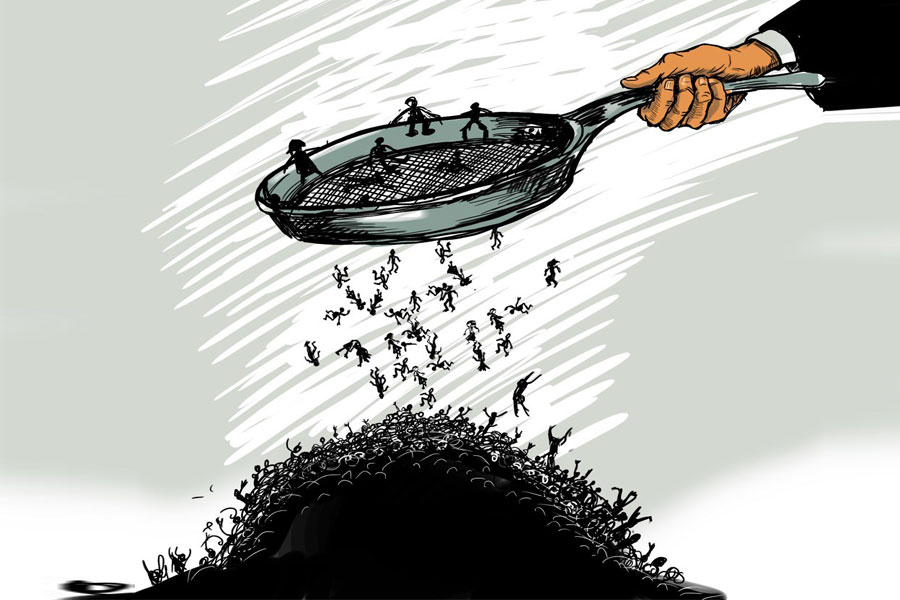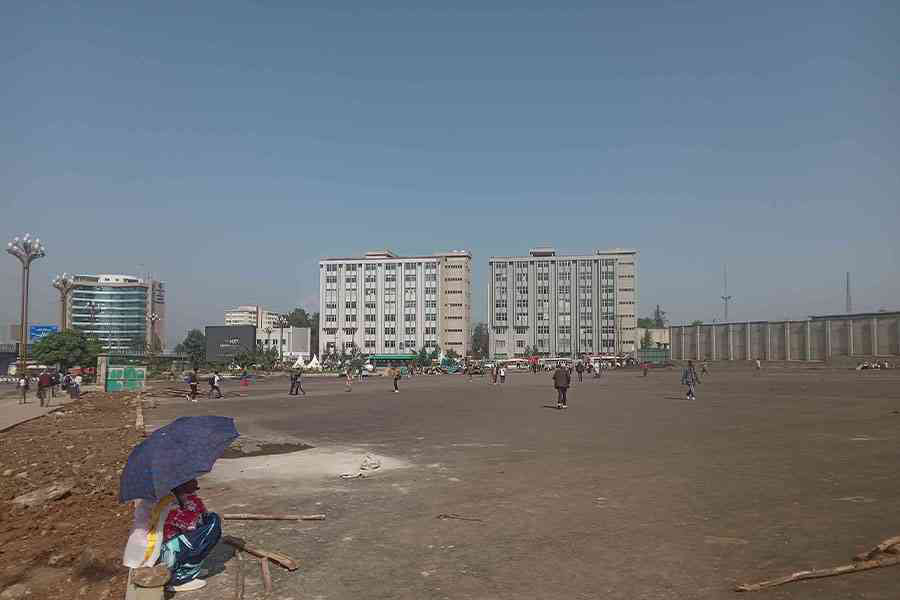
Fortune News | Oct 23,2018
Oct 16 , 2020.
The massive infestation of desert locusts that farmers in Ethiopia are faced with is the latest in a perpetually precarious position the country finds itself in. When photos and reports of the swarm colouring the rural landscape surfaces on social media, showing farmers left to their own devices in attempting to chase away the locusts from their crops, the utter absence of the state to respond to collective tribulations was glaring. It should not have been a surprise visitor at all. All the signals were there for preparedness and better response than authorities at the federal and regional agricultural bureaus have managed to muster.
The desert locust is not the world’s most dangerous migratory pest without reason. It settles over a large area of land and can travel at up to 130Km a day, depending on the speed of the winds that carry them. They eat their weight in food every day. One tonne of locusts, a tiny portion of an average swarm, consumes the same amount of food as 2,500 people in a day. A single square kilometre of land can contain anywhere between 40 million and 80 million adult locusts. This makes them agents of devastation, nightmarish to farmers anywhere in the world.
Farmers had no chance but to feel helpless. They are outnumbered and outmanoeuvred in every way that matters. Traditional means of fighting against the desert locusts were useless in this case. It may be possible to fight off a small swarm by lighting sticks on fire and making noise. But when the infestation is considered to be of the largest scale in a quarter of a century, it takes nothing less than active engagement on the part of the federal government and regional bureaus to pool responses together and respond to the threat.
They have failed farmers, and eventually consumers, terribly and miserably.
The desert locusts have now damaged 600ha of land that was cultivated during the rainy season, according to the Ministry of Agriculture, the primarily responsible federal agency for such acts of failure. Even as far back as April 2020, swarms that have been reemerging have left a million people in need of emergency food assistance, according to the Food & Agriculture Organisation (FAO), an international agency that has been ringing the alarm for close to a year now.
Another prescient warning was made in the Integrated Food Security Classification from 2019: “Of concern is the increasing presence of desert locusts that is a significant threat that warrants close monitoring as it could worsen the current food security projections."
That this will continue until at least March next year makes matters all the more depressing.
While the sheer challenge the swarms posed by the locusts is evident, there was little excuse for the government to be caught off guard. Reports from as far back as a year ago have predicted the consequences: farms in the Tigray, Oromia, Amhara and Somali regional states would be devastated, leading to the loss of at least 1.75 million tonnes of green vegetation a day, according to the FAO. Early projections for 2020 from a year ago, when the Novel Coronavirus (COVID-19) did not exist, were thus on target.
The desert locust's natural lifecycle and migratory behaviour was in fact the best evidence that a repeat of the 2019 infestation would occur. It is thus nothing less than a worrying failure in governance to respond to large-scale threats that put lives and livelihoods at risk when farmers began to lose their crops to swarms; and the government is still scrambling to receive spraying planes.
It is, of course, undeniable that the challenge here is a great deal more complicated than had it happened perhaps in any other year in the past decade. From political tensions and conflicts to COVID-19 and an economic slowdown, the government’s attention was bound to be divided. The desert locust issue has in itself become compounded by the unexpectedly heavy rainy season the year saw. It has provided opportune breeding conditions for the locusts, a matter that speaks to the adverse effects of climate change in countries such as Ethiopia.
As evidenced by the flooding that occurred during the rainy season, extreme weather conditions will likely continue to exert pressures on the country for the foreseeable future. For countries with limited resources such as Ethiopia, it is an issue that will be near unassailable. It puts the urgency in having foresight as the challenge will likely be unable to be addressed through short-term planning and preparations.
Beyond the commendable move by the National Bank of Ethiopia (NBE) to allow micro-insurance services targeted on low-income households, it is time to consider buying national disaster policies by the government. A critical point to recognise here is that these extreme conditions will likely continue to become more and more frequent as climate scientists have warned and as wildfires, heatwaves and extreme flooding occurring around the world testify.
When the risk of a particular disaster grows, it only makes sense to buy insurance to manage it. Widening social safety nets and investing in early warning systems will help. An even more reliable bet is natural disaster insurance schemes to hedge against the loss of livelihoods. Such schemes can be prepared with the support of institutions such as the World Bank. Scaled up, such insurance policies can be critical to compensating low-income households after devastating natural disasters instead of relying on largesse that may or may not come.
But the latest desert swarm portends a trend that should be just as worrying. The news of the severity of the infestation in fact came at the back of violence that left dozens dead in the Benishangul-Gumuz Regional State in the past month. Before that were flash floods. The overflow of the Awash River alone displaced 144,000 people in Afar Regional State. Then there was June, a month that saw violence erupt following the death of Hachalu Hundessa, musician and activist.
Natural events may cause some of these. Mixed in with political violence it shows a failure to anticipate, target and respond to major threats. It speaks just as much about a failure in governance and leadership as it does about the major challenges the country is faced with. As a custodian of state power, the administration of Prime Minister Abiy Ahmed (PhD) carries the burden of responsibility. Challenges may be broad and deep, but as long as it believes it can and should govern, it should be held to scrutiny when it fails to carry out its duties.
In as long as it remains to be an administration with misplaced priorities - as much preoccupied with remaking the state in its own image than the day to day challenges of citizens - it will continue to play catch up with major disasters.
PUBLISHED ON
Oct 16,2020 [ VOL
21 , NO
1068]

Fortune News | Oct 23,2018

Radar | Sep 19,2020

Commentaries | Feb 19,2022

Exclusive Interviews | Apr 19,2025

Commentaries | Mar 04,2023

My Opinion | Dec 30,2023

Verbatim | Feb 04,2023

Radar | Jul 21,2024

Editorial | Feb 04,2023

Viewpoints | Aug 18,2024

Photo Gallery | 170494 Views | May 06,2019

Photo Gallery | 160730 Views | Apr 26,2019

Photo Gallery | 150372 Views | Oct 06,2021

My Opinion | 136248 Views | Aug 14,2021

Dec 22 , 2024 . By TIZITA SHEWAFERAW
Charged with transforming colossal state-owned enterprises into modern and competitiv...

Aug 18 , 2024 . By AKSAH ITALO
Although predictable Yonas Zerihun's job in the ride-hailing service is not immune to...

Jul 28 , 2024 . By TIZITA SHEWAFERAW
Unhabitual, perhaps too many, Samuel Gebreyohannes, 38, used to occasionally enjoy a couple of beers at breakfast. However, he recently swit...

Jul 13 , 2024 . By AKSAH ITALO
Investors who rely on tractors, trucks, and field vehicles for commuting, transporting commodities, and f...

Oct 5 , 2025 . By NAHOM AYELE
In Meqelle, a name long associated with industrial grit and regional pride is undergo...

Oct 5 , 2025 . By BEZAWIT HULUAGER
The federal government is set to roll out a new "motor vehicle circulation tax" in th...

Oct 5 , 2025 . By NAHOM AYELE
The Bank of Abyssinia is wrestling with the loss of a prime plot of land once leased...

Oct 5 , 2025 . By BEZAWIT HULUAGER
The Customs Commission has introduced new tariffs on a wide range of imported goods i...